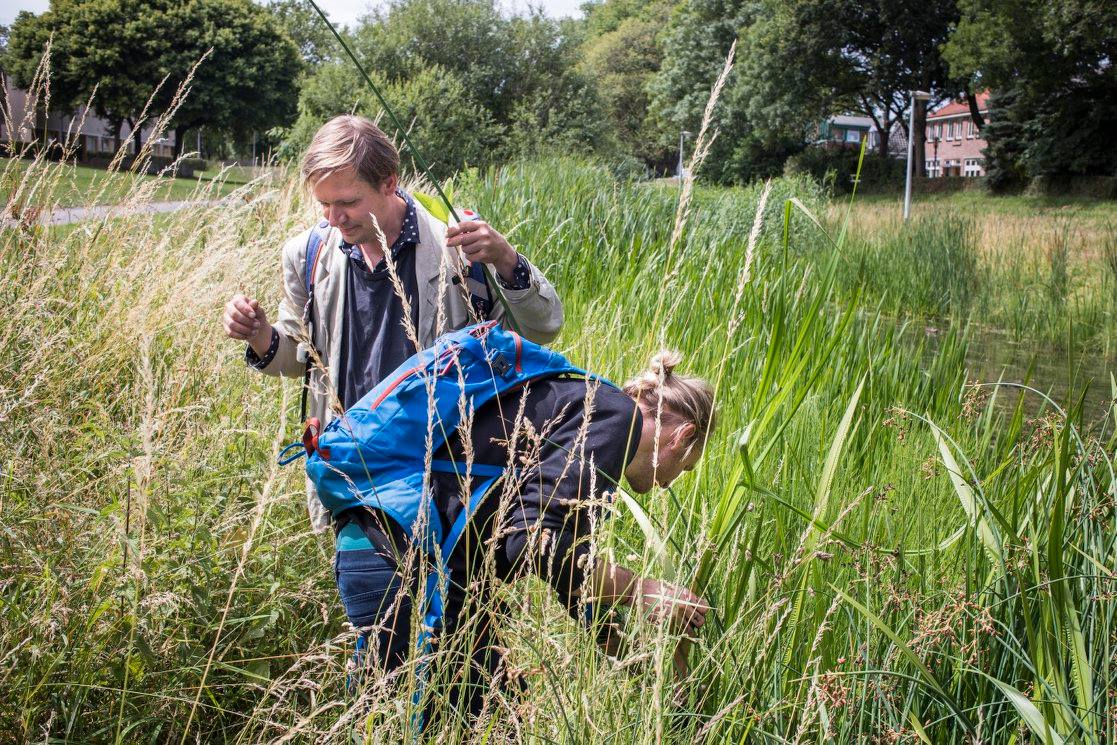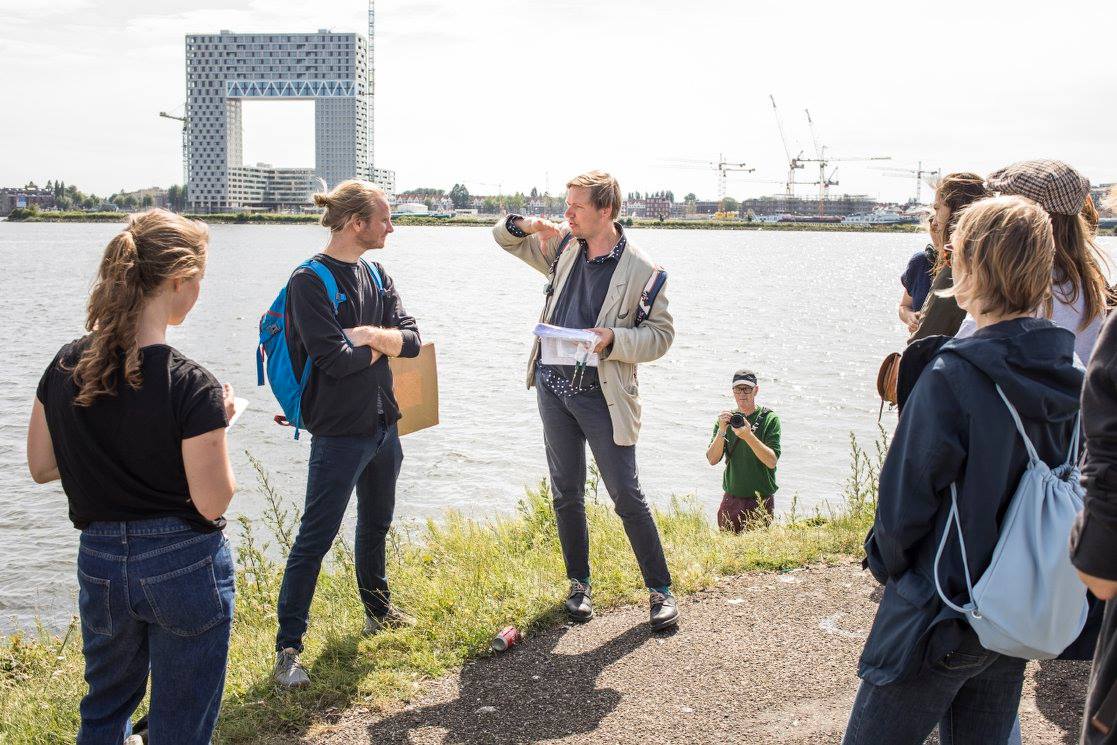Our little group meets by the Buikslotermeerplein skatepark in Amsterdam North. On this sunny Saturday, Ronald and Jonmar are waiting for us with a wooden table wagon, some interesting vegetal beverage (chicory and tilia tea) and a very appetizing cake ornamented with a nigella flower. ‘The nigellas. I got them just here, on the edge of the skatepark,’ explains Ronald. And little by little, we open our eyes to these wild weeds surrounding us.

Looking for the lesser bulrush at Buiksloterdijk / © Marlise Steeman
‘What is a weed? A plant whose virtues have not yet been discovered.’ This quote from essayist, philosopher and gardener Ralph Waldo Emerson became the motto of the Onkruidenier duo. Ronald Boer and Jonmar van Vlijmen met while studying landscape architecture at the Hogeschool Larenstein. Their passion for botany and ecology brought them to explore wild plants in nature and their potential in our daily lives. Since 2014 they have been sharing their knowledge and research in artistic, culinary and participatory projects involving wild plants at various places in the Netherlands.
The expedition they are leading this afternoon is part of the We Maken de Stad festival. With a little group of ten people, we will go through Amsterdam Noord and NDSM, along canals and brownfields, and discover the wild plants that share our everyday environment.
We listen attentively to these two storytellers. With their stories about plants come stories about their forgotten uses, the tradition they embody, the people who pick them, the culture of which they are part. By the reeds of the Buiksloterdijk, we identify the ‘lesser bulrush’, called lisdodde in Dutch, an amazing cattail whose pollen can make flour and whose stem and roots also have many cooking applications. Indeed, their first experiment with wild plants drove Onkruidenier to cooking: experimenting with the shades of bitterness of an angelica flower, mixing wild rocket salad leaves into a pesto, creating cocktails from roses or acacia flower syrup, macerating wild cappers. Harvesting the city, the Onkruidenier re-invented a playful connection with our environment, proposing tastes of landscape extracts at the Oerol Festival (in a project called ‘Gardening without boundaries’, 2015), or celebrating the new spring with special weed pancakes (presented at Sociëteit Sexyland, NDSM, Amsterdam, 2017).
Our little group is still at Buikslotermeerplein but travelling far in discussions. Diving now into more mysterious layers of knowledge about wild plants brings us to stories of soil and the plant environment. The discussion reaches Surinam, where the white clay is eaten for rituals. Jonmar presents a strange pale ball to one of us. ‘Do you want to try? I think you should just crunch and bite.’ He wants us to discover the taste of clay.
Their intense curiosity for plants brought the duo to research with botanists, archeo-botanists, geologists and others. The project ‘Halotolerante mens’ (‘Halotolerant humankind’), is one of those impressive examples of collaboration between scientific research, art, vulgarization and experimentation. Working together with the P. Thijsse Lab for nature research at the Jan van Eyck Institute, Satellite group, De Bewaerschole and the Zuiderzeemuseum, the Onkruidenier focused on the salinizing environment of the Netherlands and the halophytes, salt-loving plant species. In an investigative way, Onkruidenier immersed itself in the world of plants that can grow and survive close to the coastline. They tried to understand the lessons to be learned from the evolving qualities of halotolerant plants that use the salt that comes into their system and take advantage of it. Today, many people live below sea level and are committed to keeping out the effects of climate change and sea level rise as much as possible. We flush our polders with freshwater to reduce the salty impact, and we strengthen our dikes to protect ourselves against flooding with seawater, simply because humans are not up to salt. Onkruidenier researched the properties of salt-loving plant species and created a collection of them with which we can imagine a series of new stories about the relationship between man and the coastal landscape. Mixing a scientific and artistic approach, the installations of the Halotolerant Mens exhibition proposed new ways to interact with salty landscapes.

Exhibition ‘De halotolerante mens’ at the Bewaerschole / © de Onkruidenier
Jonmar and Ronald translate the botanical sciences into common knowledge. A mysterious beverage, a fascinating story, a collection of seeds or drawings are their teaching tools and they are efficient tools. They transform their poetic look at vegetation into artistic proposals, taking great care of the aesthetics of their presentations. That reminds us of an old aspect of the botanist’s work: the art of the botanical illustration. They reconnect with the long tradition of ‘naturalists’ illustrations’ that translate scientific knowledge into both a reliably informative drawing and a piece of art, something which has disappeared over the past century.
During their residency the Jan van Eyck Institute, where they experimented with various media such as photography, drawings and installations, their exhibitions found a balance between the artistic and scientific eye.
Vagabondage: By the Noordhollands Kanaal we find a Malus Sylvestris, a wild apple tree native to Kazakhstan. We learn here that the tree of bitter fruits most likely grew from an apple core thrown away by a skipper on his slow journey along on the canal. Travels by seeds, colonization, exotics meeting autochthones: the Onkruidenier started one of its first workshops on this topic in the same area, on the industrial brownfields of Amsterdam Noord. Identifying soya and other exotic species that grow spontaneously on the banks of the IJ, Ronald and Jonmar started researching the history and activity of the port by listing the wild plants. They collected ‘samples of the harbour botany’, some of which we receive at the end of the workshop, and invite us to pursue the odyssey of these species and help them find new territory.
Their interest in the ‘vagabondage’ of plants calls to mind the research and designs of Gilles Clément, a French landscape architect who prefers to call himself a gardener, and whose passion for botany brought him to explore what he himself calls the ‘Third Landscape’. In reference to the term ‘Third World’, which denotes developing countries, Clément identifies ‘wild plants’ as a third party long forgotten by landscape designers, and easily rejected from the gardening’s aesthetic criteria. Through his ‘gardens in movement’ (whose famous examples can be seen in Parc Citroen or Quai Branly in Paris), Clément introduces wild plants into landscape design, accepting and using their dynamism, conquest, vagrancy and entropy, to draw gardens that take different shapes with each new flowering.

Discovering travelling seeds by the river IJ / © Marlise Steeman
With a different approach but similar poetry, the Onkruidenier revalorizes this ‘Third Landscape’, this world of wild, freely travelling plants. And at a time when climate change and globalization speed up the migration of plants from one continent to another, this positive look at the shifting cartography of botanical repartition is very necessary.
The Onkruidenier is now taking it to a new level with the project ‘Buurtsuper’, the first open-air supermarket, developed in Amsterdam Noord this summer. Once species are identified and their stories revealed, and once new applications have been found for these wild plants, the Buurtsuper proposes a place to host the harvested weeds and teach how we can produce all kinds of products that we buy every day in the supermarket with plants that grow in the city. The place, already materialized with plantations of ‘wild’ aromatic species (thymus, verbena, …) around the Buikslotermeeplein skatepark, was the starting point in spring 2018 for regular workshops in the district: discover plants, collect them, experiment with them in the kitchen, learn conservation recipes, and taste ‘the edible city’. Always equipped with their ‘fieldwork station’, a mobile set of furniture that includes a drying cabinet, ladder and harvesting bench or field kitchen, the duo are the new explorers of our immediate environment, and their curious eyes and experimenting minds give us new tools and knowledge to live together with it.
From this spring, the adventures of the Buurtsuper start again: with a series of new plantations in the oasis of Buikslotermeerplein, to which anyone is welcome to join. More information on the website of the Onkruidenier.